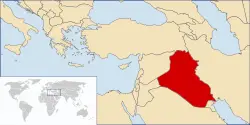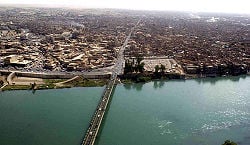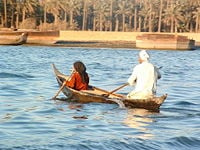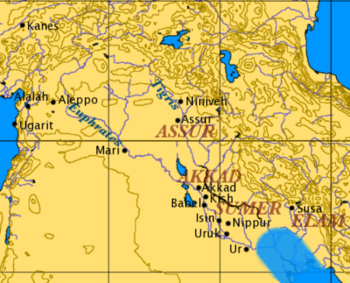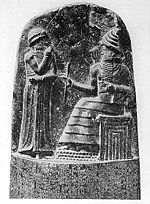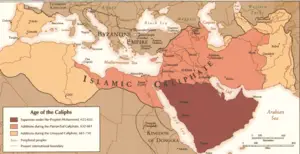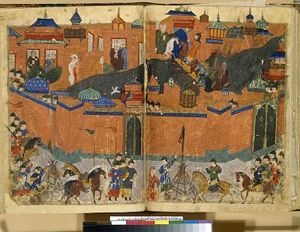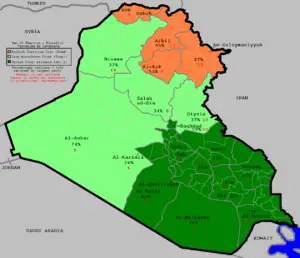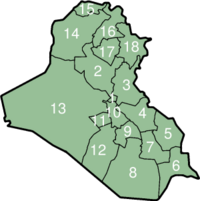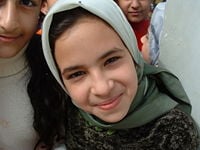Difference between revisions of "Iraq" - New World Encyclopedia
Mike Butler (talk | contribs) m |
Mike Butler (talk | contribs) m |
||
| Line 134: | Line 134: | ||
At this point Baghdad was ruled by the [[Il-Khanids]], the [[Mongol]] emperors of [[Iran]]. In 1401, Baghdad was again sacked, by [[Timur]] ("Tamerlane"). It became a provincial capital controlled by the [[Jalayirid]] (1400–1411), [[Black Sheep Turkmen|Qara Quyunlu]] (1411–1469), [[White Sheep Turkmen|Aq Quyunlu]] (1469–1508), and [[Safavid]] (1508–1534) dynasties. The [[Ottoman Empire]] took [[Baghdad]] in 1535, cementing Suleiman I as the leader of the Islamic world and the legitimate successor to the Abbasid Caliphs. Ottoman rule lasted until [[World War I]], during which the Ottomans sided with [[Germany]] and the [[Central Powers]]. | At this point Baghdad was ruled by the [[Il-Khanids]], the [[Mongol]] emperors of [[Iran]]. In 1401, Baghdad was again sacked, by [[Timur]] ("Tamerlane"). It became a provincial capital controlled by the [[Jalayirid]] (1400–1411), [[Black Sheep Turkmen|Qara Quyunlu]] (1411–1469), [[White Sheep Turkmen|Aq Quyunlu]] (1469–1508), and [[Safavid]] (1508–1534) dynasties. The [[Ottoman Empire]] took [[Baghdad]] in 1535, cementing Suleiman I as the leader of the Islamic world and the legitimate successor to the Abbasid Caliphs. Ottoman rule lasted until [[World War I]], during which the Ottomans sided with [[Germany]] and the [[Central Powers]]. | ||
| − | + | ===World War I=== | |
During [[World War I]] the British drove the [[Ottomans]] from much of the area during the dissolution of the Ottoman Empire. The British lost 92,000 soldiers in the [[Mesopotamian campaign]]. Ottoman losses are unknown but the British captured a total of 45,000 prisoners of war. By the end of 1918 the British had deployed 410,000 men in the area, though only 112,000 were combat troops. | During [[World War I]] the British drove the [[Ottomans]] from much of the area during the dissolution of the Ottoman Empire. The British lost 92,000 soldiers in the [[Mesopotamian campaign]]. Ottoman losses are unknown but the British captured a total of 45,000 prisoners of war. By the end of 1918 the British had deployed 410,000 men in the area, though only 112,000 were combat troops. | ||
| Line 150: | Line 150: | ||
A coup d'etat of the [[Iraqi Army]], known as the [[14 July Revolution]], in 1958, overthrew the reinstated [[Hashemite]] monarchy, and brought Brigadier General [[Abdul Karim Qassim to power. He withdrew from the [[Baghdad Pact]] and established friendly relations with the [[Soviet Union]]. But his government lasted only until 1963, when it was overthrown by Colonel Abdul Salam, who died in 1966 and his brother, Abdul Rahman Arif, assumed the presidency. In 1968, the Arab Socialist [[Baath Party]] seized power. This movement gradually came under the control of [[Saddam Hussein|Saddam Hussein al-Majid al Tikriti]], who acceded to the presidency and control of the Revolutionary Command Council (RCC), then Iraq's supreme executive body, in July 1979, while killing off many of his opponents. | A coup d'etat of the [[Iraqi Army]], known as the [[14 July Revolution]], in 1958, overthrew the reinstated [[Hashemite]] monarchy, and brought Brigadier General [[Abdul Karim Qassim to power. He withdrew from the [[Baghdad Pact]] and established friendly relations with the [[Soviet Union]]. But his government lasted only until 1963, when it was overthrown by Colonel Abdul Salam, who died in 1966 and his brother, Abdul Rahman Arif, assumed the presidency. In 1968, the Arab Socialist [[Baath Party]] seized power. This movement gradually came under the control of [[Saddam Hussein|Saddam Hussein al-Majid al Tikriti]], who acceded to the presidency and control of the Revolutionary Command Council (RCC), then Iraq's supreme executive body, in July 1979, while killing off many of his opponents. | ||
| − | + | ===Saddam Hussein=== | |
[[Image:Saddam Hussein(222).jpg|thumb|200px|right|Saddam Hussein, c. 2000]] | [[Image:Saddam Hussein(222).jpg|thumb|200px|right|Saddam Hussein, c. 2000]] | ||
Saddam's regime lasted throughout the [[Iran-Iraq War]] (1980–1988), during which Iraqi forces attacked [[Military of Iran|Iranian soldiers]] and civilians with [[Chemical warfare|chemical weapons]]. The war ended in stalemate. This period is notorious for the Saddam regime's [[Human rights in Saddam Hussein's Iraq|human rights abuses]], for instance, during the [[Al-Anfal campaign]]. | Saddam's regime lasted throughout the [[Iran-Iraq War]] (1980–1988), during which Iraqi forces attacked [[Military of Iran|Iranian soldiers]] and civilians with [[Chemical warfare|chemical weapons]]. The war ended in stalemate. This period is notorious for the Saddam regime's [[Human rights in Saddam Hussein's Iraq|human rights abuses]], for instance, during the [[Al-Anfal campaign]]. | ||
| Line 177: | Line 177: | ||
The politics of Iraq takes place in a framework of a more or less federal parliamentary representative democratic republic, whereby the prime minister is the head of government, and of a pluriform multi-party system. | The politics of Iraq takes place in a framework of a more or less federal parliamentary representative democratic republic, whereby the prime minister is the head of government, and of a pluriform multi-party system. | ||
| − | + | According to the 2005 constitution, the executive branch of government comprises the Prime Minister, who was Nouri al-Maliki in 2007, who holds most of the executive authority and appoints the cabinet, and the president, who was Jalal Talabani in 2007, who serves in a figurehead capacity, with few powers. The president and vice presidents comprise the Presidency Council, which appoints a 37-minister cabinet. | |
| − | + | The constitution includes a bicameral legislative body, or parliament. The lower house is the Council of Representatives, consisting of 275 members of parliament, elected nationwide by a closed-list, proportional representation system. Elections, held on December 15, 2005, resulted in the Unified Iraqi Alliance taking 41percent of the vote, Kurdistan Alliance 22 percent, Tawafuq Coalition 15 percent, Iraqi National List 8 percent, Iraqi Front for National Dialogue 4 percent, and other, 10 percent. The speaker was to be elected by the House. | |
| − | + | [[Image:Iraq_Dec05_Elect.png|right|thumb|300px|[[Iraqi legislative election, December 2005|December 2005 election]] results by plurality (not proportional representation, as was used).]] | |
| − | [[Image: | + | The upper house would be the Council of Union, and the members would be known as senators. It would have 50 senators from each Sunni, Kurdish, and Shia senatorial districts. The president of the senate would be a vice president in the Presidency Council chosen by the president. |
| − | |||
| − | |||
| − | + | The constitution calls for a Federal Judicial Authority, comprised of the Higher Juridical Council, Supreme Federal Court, Federal Court of Cassation, Public Prosecution Department, Judiciary Oversight Commission and other federal courts to be regulated in accordance with the law. | |
| − | + | ===Ba'ath rule=== | |
| + | Before the fall of [[Saddam Hussein]] in 2003, the [[Ba'ath Party]] officially ruled [[Iraq]] through a nine-member Revolutionary Command Council, which enacted legislation by decree. The council's president (chief of state and supreme commander of the armed forces) was elected by a two-thirds majority of the council. A council of ministers ([[cabinet]]), appointed by the council., had administrative and some legislative responsibilities. A 250-member National Assembly consisting of 220 elected by popular vote who serve a four-year term, and 30 appointed by the president to represent the three northern provinces, was last elected in March 2000. | ||
| − | + | A constitution, voted on by 63 percent of eligible voters on October 15, 2005, was passed with a 78 percent overall majority. The degree of support varied widely, with overwhelming backing among the Shia and Ķurdish communities, but overwhelmingly rejection by Arab Sunnis. Three majority Arab Sunni provinces rejected it ([[Salah ad Din]] with 82 percent against, [[Ninawa]] with 55 percent against, and [[Al Anbar]] with 97 percent against). Under the terms of the constitution, the country conducted fresh nationwide parliamentary elections on December 15 to elect a new government. The overwhelming majority of all three major ethnic groups in Iraq voted along ethnic lines, turning this vote into more of an ethnic census than a competitive election, and setting the stage for the division of the country along ethnic lines. | |
| − | === | + | ===Factions=== |
| − | + | Iraqi politicians have been under significant threat by the various factions that have promoted violence as a political weapon. An insurgency against the Government of Iraq and Coalition forces is concentrated in Baghdad and in areas north, northeast, and west of the capital. The diverse, multi-group insurgency consists principally of Sunni Arabs, whose only common denominator is a shared desire to oust the Coalition and end U.S. influence in Iraq, a number of predominantly Shia militias, and some associated with political parties, challenge governmental authority in Baghdad and southern Iraq. | |
| − | |||
| − | + | The capital of Baghdad was in the middle of a power struggle in 2007, with insurgents forcing out Shi'ite residents in some areas of western Baghdad where the Sunni sect is in the majority. After the bombing of a Shi'ite shrine in Samarra, north of Baghdad, Shi'ite militias retaliated and forced out some Sunnis from predominantly Shi'ite areas. | |
| − | |||
| − | |||
| − | |||
| − | |||
| − | |||
| − | |||
| − | |||
| − | |||
| − | |||
| − | |||
| − | |||
| − | |||
| − | |||
| − | |||
| − | |||
| − | |||
| − | |||
| − | |||
| − | |||
| − | |||
| − | |||
| − | |||
| − | |||
| − | |||
| − | |||
| − | |||
| − | |||
| − | + | There are a number of ethnic minority groups in Iraq: Kurds, Assyrians, Mandeans, Iraqi Turkmen, Shabaks and Roma people. These groups have not enjoyed equal status with the majority Arab populations throughout Iraq's 85-year history. Since the establishment of the "no-fly zones" following the [[Gulf War]] of 1990-1991, the situation of the Kurds has changed as they have established their own autonomous region. The remainder of these ethnic groups continue to suffer discrimination on religious or ethnic grounds. | |
| − | + | [[Image:IraqNumberedRegions.png|200px|right|Numbered map of Governorates of Iraq|]] | |
| + | Iraq is divided into 18 governorates (or provinces). The governorates are subdivided into ''qadhas'' (or districts). The new constitution provides for regions to be created by combining one or more governorates. There was only one region in existence in 2007 - [[Iraqi Kurdistan]] - and there are proposals for one or more further regions to be created in the south. The 2007 governorates were: Baghdad, 1; Salah ad Din, 2; Diyala, 3; Wasit, 4; Maysan, 5; Al Basrah, 6; Dhi Qar, 7; Al Muthanna, 8; Al-Qādisiyyah, 9; Babil, 10; Karbala, 11; An Najaf, 12; Al Anbar, 13; Ninawa, 14; Dahuk, 15; Arbil, 16; At Ta'mim (Kirkuk), 17; and As Sulaymaniyah, 18. | ||
==Economy== | ==Economy== | ||
Revision as of 22:13, 3 May 2007
| جمهورية العراق Jumhūrīyat al-`Irāq كۆماری عێراق `Îraqê Republic of Iraq | |||||
| |||||
| Motto: الله أكبر (Arabic) "Allahu Akbar" (transliteration) "God is Great" | |||||
| Anthem: Mawtini (new) Ardh Alforatain (previous)1 | |||||
| Capital | Baghdad2 33°20′N 44°26′E | ||||
|---|---|---|---|---|---|
| Largest city | capital | ||||
| Official languages | Arabic, Kurdish | ||||
| Government | Developing parliamentary democracy | ||||
| - President | Jalal Talabani | ||||
| - Prime Minister | Nouri al-Maliki | ||||
| Independence | |||||
| - from the Ottoman Empire | October 1 1919 | ||||
| - from the United Kingdom | October 3 1932 | ||||
| Area | |||||
| - Total | 438,317 km² (58th) 169,234 sq mi | ||||
| - Water (%) | 1.1 | ||||
| Population | |||||
| - 2006 estimate | 26,783,3834 | ||||
| - Density | 66/km² 171/sq mi | ||||
| GDP (PPP) | 2005 estimate | ||||
| - Total | $89.8 billion | ||||
| - Per capita | $3,600 | ||||
| Currency | Iraqi dinar (IQD)
| ||||
| Time zone | AST (UTC+3) | ||||
| - Summer (DST) | ADT (UTC+4) | ||||
| Internet TLD | .iq | ||||
| Calling code | +964 | ||||
The Republic of Iraq, commonly known as Iraq is a country in Southwest Asia spanning most of Mesopotamia as well as the north-western end of the Zagros mountain range and the eastern part of the Syrian Desert.
The land area now known as modern Iraq was almost equivalent to Mesopotamia, the world's first civilization. It was on the banks of the Tigris, which passes through the capital Baghdad, that writing is believed to have originated. During its long history, it has been part of the Persian, Ottoman and British empires.
While its proven oil reserves of 112 billion barrels ranks Iraq second in the world behind Saudi Arabia, the United States Department of Energy estimates that up to 90 percent of the country remains unexplored.
Today, Iraq is a developing nation that is the focus of increased attention from the West because of the Iraq War.
Geography
There are several suggested origins for the name Iraq. One dates to the Sumerian city of Uruk (or Erech); another posits that Iraq comes from the Aramaic language, meaning "the land along the banks of the rivers;" another, that Iraq refers to the root of a palm tree numerous in the country. Under the Persian Sassanid dynasty, there was a region called "Erak Arabi," referring to the part of the south western region of the Persian Empire that is now part of southern Iraq. The name Al-Iraq was used by the Arabs themselves, from the sixth century, for the land Iraq covers.
It shares borders with Kuwait and Saudi Arabia to the south, Jordan to the west, Syria to the northwest, Turkey to the north, and Iran to the east. It has a very narrow section of coastline at Umm Qasr on the Persian Gulf.
At 168,743 square.miles (437,072 square kilometers), Iraq is the 58th-largest country in the world, after Morocco. It is comparable in size to the U.S. state of California, and somewhat larger than Paraguay.
The country has four main zones or regions: the desert in the west and southwest; the rolling upland between the upper Tigris and Euphrates rivers (in Arabic the Dijlis and Furat, respectively); the highlands in the north and northeast; and the alluvial plain through which the Tigris and Euphrates flow. Iraq has a small coastline with the Persian Gulf. Close to the coast and along the Shatt al-Arab (known as arvandrūd among Iranians) there used to be marshlands, but many of these were drained in the 1990s.
The highest point is a 11,847-foot (3611-meter) point, unnamed on the map opposite, but known locally as Cheekah Dar (black tent).
The local climate is mostly desert with mild to cool winters and dry, hot, cloudless summers. The northern mountainous regions experience cold winters with occasional heavy snows, sometimes causing extensive flooding. Average temperatures in range from higher than 120°F (48°C) in July and August to below freezing in January. Most of the rainfall occurs from December through April and averages between four to seven inches (100mm and 180mm) annually.
The two main rivers are the (Euphrates and Tigris). The Euphrates originates in Turkey, is augmented by the Khabur River in Syria, and flows through Iraq from the northwest to join the Tigris at Al Qurnah. The Tigris also rises in Turkey, is significantly augmented in Iraq by the Khabur River, the Great Zab, the Little Zab, and the Uzaym, above Baghdad, and the Diyala, which joins it below the city. At the Kut Barrage much of the water is diverted into the Shatt al Gharraf, which was once the main channel of the Tigris. Water from the Tigris thus enters the Euphrates through the Shatt al Gharraf well above the confluence of the two main channels at Al Qurnah. The two rivers carry about 60 million cubic metres (78 million cu. yd) of silt annually to the delta.
The combination of rain shortage and extreme heat makes much of Iraq a desert. Because of high rates of evaporation, soil and plants rapidly lose the little moisture obtained from the rain, and vegetation could not survive without extensive irrigation. Some areas, however, although arid, do have natural vegetation in contrast to the desert. For example, in the Zagros Mountains in north-eastern Iraq there is permanent vegetation, such as oak trees, and date palms are found in the south.
Natural hazards include dust storms, sandstorms, and floods.
Government water control projects have drained most of the inhabited marsh areas east of Nasiriyah by drying up or diverting the feeder streams and rivers, thus displacing; a once sizable population of Marsh Arabs, who inhabited these areas for thousands of years. Destruction of the natural habitat poses threats to the area's wildlife populations. Other environmental problems include inadequate supplies of drinking water, air and water pollution, soil degradation (salination) and erosion, and desertification.
While its proven oil reserves of 112 billion barrels ranks Iraq second in the world behind Saudi Arabia, the United States Department of Energy estimates that up to 90 percent of the country remains unexplored. Unexplored regions of Iraq could yield an additional 100 billion barrels. Iraq's oil production costs are among the lowest in the world. However, only about 2000 oil wells have been drilled in Iraq, compared to about one million wells in Texas
Settlement clusters near the rivers, streams, and irrigation canals. Baghdad, the capital, has a metropolitan area population estimated at seven million people. It is the largest city in Iraq, and the second-largest city in southwest Asia (after Tehran). Baghdad has at least 12 bridges to join the east and west of the city separated by the river Tigris. Other cities include Basra in the south and Mosul in the north.
History
Iraq was historically known as Mesopotamia, which, in Greek, literally means "between the rivers". Mesopotamian history extends from the emergence of urban societies in Southern Iraq in the fourth millennium B.C.E., to the arrival of Alexander the Great in the fourth century B.C.E. Mesopotamia housed some of the world's most ancient states with highly developed social complexity. The region was as one of the famous four river civilizations where writing was invented, along with the Nile valley in Egypt, the Indus Valley in the Indian Subcontinent and Yellow River valley in China.
It was home to the world's first known civilization, the Sumerian culture, that flourished around 3000 B.C.E. The Sumerians battled the Elamites living in what is now western Iran. In 2340 B.C.E., the great Akkadian leader Sargon of Akkad conquered Sumer and built the Akkadian Empire stretching over most of the Sumerian city-states and extending as far away as Lebanon. The Akkadians were a Semitic people, who had migrated from the Arabian Peninsula. In 2125 B.C.E., the Sumerian city of Ur in southern Mesopotamia rose up in revolt.
King Hammurabi of Babylon (1792-1750 B.C.E.) re-united the region. Babylonian rule covered most of the Tigris-Euphrates river valley from Sumer and the Persian Gulf, and extended to the coast of the Mediterranean Sea. The Assyrians (ca 2000 B.C.E. to 700 B.C.E.) came to control Babylonia, until revolts in turn deposed them and set up a new dynasty, known as the Second Dynasty of Isin. Nebuchadnezzar I (Nabu-kudurri-usur; c. 1119 B.C.E. to 1098 B.C.E.) is the best-known ruler from this dynasty.
Eventually, during the 800s B.C.E., a powerful tribe from outside Babylon, the Chaldeans, rose to power in Babylonia, which came to be known as Chaldea. In 626 B.C.E., the Chaldeans helped Nabo-Polassar to take power in Babylonia. At that time, Assyria was under considerable pressure from the Iranian Medes (from Media). Nabo-Polassar allied Babylonia with the Medes. In 612 B.C.E., Nineveh, the capital of Assyria, fell. The entire city, once the capital of a great empire, was burned and sacked.
Nebuchadrezzar II (604-562 B.C.E.), who was Nabopolassar's son, inherited the empire of Babylonia. In the (586 B.C.E.), Nebuchadrezzar II conquered Judea, destroyed Jerusalem, including Solomon's Temple, and sent an estimated 15,000 captives, into exile in Babylonia. Nebuchadrezzar is credited for building the legendary Hanging Gardens of Babylon, one of the Seven Wonders of the World.
These civilizations produced the earliest writing and some of the first sciences, mathematics, laws and philosophies of the world; hence its common epithet, the "Cradle of Civilization". Ancient Mesopotamian civilization dominated other civilizations. Mesopotamia housed historically important cities such as Uruk (ca 4000 B.C.E. - 3100 B.C.E.), Nippur (from 5000 B.C.E.), Nineveh (ca 1800 B.C.E.- 612 B.C.E.), and Babylon as well as the Third Dynasty of Ur (ca 2119 B.C.E. - 2004 B.C.E.)
Persian domination
Various invaders conquered the land after Nebuchadrezzar's death, including Persian Cyrus the Great in 539 B.C.E., and Alexander the Great in 331 B.C.E., who died there in 323 B.C.E. It remained under Greek rule under the Seleucid dynasty for nearly two centuries. Babylon declined after the founding of Seleucia on the Tigris, the new Seleucid Empire capital. A Central Asian tribe of Iranian peoples called Parthians then annexed the region followed by the Sassanid Persians until the seventh century]].
The Arabic term "Iraq" is widely used in the medieval Arabic sources for the area in the centre and south of the modern republic as a geographic rather than a political term, implying no precise boundaries. Until 602 C.E., the desert frontier of greater Iran had been guarded by the Lakhmid kings of Al-Hirah, who were Arabs ruling a settled buffer state. In that year Shahanshah Khosrow II Aparviz rashly abolished the Lakhmid kingdom and laid the frontier open to nomad incursions. Syria and Turkey (which is inhabited by Kurds of Iranian race) were parts of Iran. Iraq was the capital of Iran for more than 1000 years. After Islam, the holy shiite places like Najaf and Karbala made Iraq the capital of shiite Muslims and the center of Iranian civilization until the establishment of modern Iraq. Iranians continue to call Iraqis brothers, and numerous Iraqis speak Iranian languages like Kurdish and Farsi.
The desert frontier of greater Iran had been guarded by the Lakhmid kings of Al-Hirah, who were Arabs ruling a settled buffer state. In 602 C.E.,Shahanshah Khosrow II Aparviz rashly abolished the Lakhmid kingdom and laid the frontier open to nomad incursions. Syria and Turkey (which is inhabited by Kurds of Iranian race) were parts of Iran. Iraq was the capital of Iran for more than 1000 years. After Islam, the holy Shi’ite places like Najaf and Karbala made Iraq the capital of shiite Muslims and the center of Iranian civilization until the establishment of modern Iraq. Iranians continue to call Iraqis brothers, and numerous Iraqis speak Iranian languages like Kurdish and Farsi.
Arab conquest
Beginning in the seventh century C.E., Islam spread to what is now Iraq during the Islamic conquest of Persia, led by the Muslim Arab commander Khalid ibn al-Walid. Under the Rashidun Caliphate, the prophet Mohammed's cousin and son-in-law Ali moved his capital to Kufa "fi al-Iraq" when he became the fourth caliph. The Umayyad Caliphate, ruling from Damascus in the seventh century, ruled the province of Iraq.
The city of Baghdad was built in the eighth century as the capital of the Abbasid Caliphate, and became the leading city of the Arab and Muslim world for five centuries. Baghdad was the largest multicultural city of the Middle Ages, peaking at a population of more than a million, and was the centre of learning during the Islamic Golden Age, until its eventual destruction during the Battle of Baghdad in 1258.
Mongol conquest
In 1257, Hulagu Khan amassed an unusually large army, perhaps 10 percent of all available Mongol fighters, for the purpose of conquering Baghdad. When they arrived at the Islamic capital, Hulagu demanded surrender but the caliph refused. This angered Hulagu, and, consistent with Mongol strategy of discouraging resistance, Bagdhad was decimated. Estimates of the numbers killed range from 200,000 to a million. The Grand Library of Baghdad, containing countless precious historical documents was destroyed along with the Abbasid Caliphate. The caliph was captured, forced to watch as his citizens were murdered and his treasury plundered, and was killed by trampling. The Mongols rolled the caliph up in a rug, and rode their horses over him, as they believed that the earth was offended if touched by royal blood. All but one of his sons was killed. The canals and dykes forming the city's irrigation system were also destroyed. Baghdad was a depopulated, ruined city for several centuries and only gradually recovered some of its former glory.
Ottoman rule
At this point Baghdad was ruled by the Il-Khanids, the Mongol emperors of Iran. In 1401, Baghdad was again sacked, by Timur ("Tamerlane"). It became a provincial capital controlled by the Jalayirid (1400–1411), Qara Quyunlu (1411–1469), Aq Quyunlu (1469–1508), and Safavid (1508–1534) dynasties. The Ottoman Empire took Baghdad in 1535, cementing Suleiman I as the leader of the Islamic world and the legitimate successor to the Abbasid Caliphs. Ottoman rule lasted until World War I, during which the Ottomans sided with Germany and the Central Powers.
World War I
During World War I the British drove the Ottomans from much of the area during the dissolution of the Ottoman Empire. The British lost 92,000 soldiers in the Mesopotamian campaign. Ottoman losses are unknown but the British captured a total of 45,000 prisoners of war. By the end of 1918 the British had deployed 410,000 men in the area, though only 112,000 were combat troops.
During World War I the British and French divided the Middle East in the Sykes-Picot Agreement. The Treaty of Sèvres, which was ratified in the Treaty of Lausanne, led to the advent of the modern Middle East and Republic of Turkey. The League of Nations granted France mandates over Syria and Lebanon and granted the United Kingdom mandates over Iraq and Palestine (which then consisted of two autonomous regions: Palestine and Transjordan). Parts of the Ottoman Empire on the Arabian Peninsula became parts of what are today Saudi Arabia and Yemen.
British mandate
At the end of World War I, the League of Nations granted the area to the United Kingdom as a mandate. It was formed out of three former Ottoman vilayets (regions): Mosul, Baghdad, and Basra. For three out of four centuries of Ottoman rule, the vilayets of Baghdad, Mosul, and Basra were administered from Baghdad. During the British mandate, British colonial administrators who used the British armed forces to put down rebellions ruled the country. They selected the Hashemite king, Faisal I, who had been forced out of Syria by the French, to be their client ruler. The government and ministries' officers were likewise appointed by British authorities, selected from the Sunni Arab elite in the region.
Before the collapse of the Ottoman Empire, the British-controlled Turkish Petroleum Company had held concessionary rights to the Mosul province. In March 1925, after acrimonious discussions over the oil concession, an agreement was concluded that granted the renamed Iraq Petroleum Company a concession for 75 years.
Hashemite monarchy
Iraq was granted independence in 1932 on the urging of King Faisal, though the British retained military bases and transit rights for their forces. King Ghazi ruled as a figurehead after King Faisal's death in 1933, while undermined by attempted military coups (dictatorships), until his death in 1939. The United Kingdom invaded Iraq in 1941 for fear that the government of Rashid Ali might cut oil supplies to Western nations, and because of his strong idealogical leanings to Nazi Germany. A military occupation followed the restoration of the Hashemite monarchy, and the occupation ended on October 26, 1947. The rulers during the occupation and the remainder of the Hashemite monarchy were Nuri al-Said, the autocratic prime minister, who also ruled from 1930-1932, and 'Abd al-Ilah, an advisor to the king Faisal II.
Republic of Iraq
A coup d'etat of the Iraqi Army, known as the 14 July Revolution, in 1958, overthrew the reinstated Hashemite monarchy, and brought Brigadier General [[Abdul Karim Qassim to power. He withdrew from the Baghdad Pact and established friendly relations with the Soviet Union. But his government lasted only until 1963, when it was overthrown by Colonel Abdul Salam, who died in 1966 and his brother, Abdul Rahman Arif, assumed the presidency. In 1968, the Arab Socialist Baath Party seized power. This movement gradually came under the control of Saddam Hussein al-Majid al Tikriti, who acceded to the presidency and control of the Revolutionary Command Council (RCC), then Iraq's supreme executive body, in July 1979, while killing off many of his opponents.
Saddam Hussein
Saddam's regime lasted throughout the Iran-Iraq War (1980–1988), during which Iraqi forces attacked Iranian soldiers and civilians with chemical weapons. The war ended in stalemate. This period is notorious for the Saddam regime's human rights abuses, for instance, during the Al-Anfal campaign.
Osirak (also spelled Osiraq) was constructed by the Iraqi government at the Al Tuwaitha Nuclear Research Center, 18 km (11 miles) south-east of Baghdad in 1977. It was a 40 MW light-water nuclear materials testing reactor (MTR). Israeli aircraft bombed it in 1981, in order to prevent the regime from using the reactor for creation of nuclear weapons.
Gulf War
In 1990, Iraq invaded Kuwait, resulting in the Gulf War and economic sanctions imposed by the United Nations at the behest of the U.S. The economic sanctions were intended to compel Saddam to dispose of weapons of mass destruction. Critics estimate that more than 500,000 Iraqi children died as a result of the sanctions. The U.S. and the UK declared no-fly zones over Kurdish northern and Shiite southern Iraq to oversee the Kurds and southern Shiites.
2003 invasion
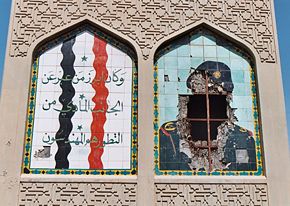
Iraq was invaded in March 2003 by a United States-organized coalition, with the stated reason that Iraq had not abandoned its nuclear and chemical weapons development program according to United Nations resolution 687. When Iraq invaded Kuwait, the United Nations Security Council, under Chapter VII of the United Nations Charter, adopted resolution 678, authorizing armed action against Iraq. After Iraq was expelled from Kuwait the United Nations passed a cease-fire resolution 687. The agreement included provisions obligating Iraq to discontinue its nuclear weapons program. The United States asserted that because Iraq was in "material breach" of resolution 687, the armed forces authorization of resolution 678 was revived.
The public justifications, given for invasion including purported Iraqi government links to Al Qaeda, claimed that Iraq had weapons of mass destruction, and that they had the opportunity to remove an oppressive dictator from power, and to bring democracy to Iraq. In his State of Union Address on January 29, 2002, the American President George W. Bush declared that Iraq was a member of the "axis of evil"; and that, like North Korea and Iran, Iraq's attempt to acquire weapons of mass destruction gave credentials to the claim that the Iraqi government posed a serious threat to America's national security.”
Post-invasion Iraq
The United States established the Coalition Provisional Authority to govern Iraq. Government authority was transferred to an Iraqi Interim Government in 2004 and a permanent government was elected in October 2005. More than 140,000 Coalition troops remain in Iraq. Studies have placed the number of civilian deaths as between 65,500 and 655,000. After the invasion, al-Qaeda took advantaged of the insurgency to entrench itself in the country concurrently with a Arab-Sunni led insurgency and sectarian violence. In 2006 Foreign Policy Magazine named Iraq as the fourth most unstable nation in the world.
On December 30, 2006, Saddam Hussein was hanged. Hussein's half-brother and former intelligence chief Barzan Ibrahim al-Tikriti and former chief judge of the Revolutionary Court Awad Hamed al-Bandar were likewise executed on January 15, 2007, as was Taha Yassin Ramadan, Saddam's former deputy and former vice-president (originally sentenced to life in prison but later to death by hanging), on March 20, 2007. Ramadan was the fourth and last man in the al-Dujail trial to die by hanging.
Government and politics
The politics of Iraq takes place in a framework of a more or less federal parliamentary representative democratic republic, whereby the prime minister is the head of government, and of a pluriform multi-party system.
According to the 2005 constitution, the executive branch of government comprises the Prime Minister, who was Nouri al-Maliki in 2007, who holds most of the executive authority and appoints the cabinet, and the president, who was Jalal Talabani in 2007, who serves in a figurehead capacity, with few powers. The president and vice presidents comprise the Presidency Council, which appoints a 37-minister cabinet.
The constitution includes a bicameral legislative body, or parliament. The lower house is the Council of Representatives, consisting of 275 members of parliament, elected nationwide by a closed-list, proportional representation system. Elections, held on December 15, 2005, resulted in the Unified Iraqi Alliance taking 41percent of the vote, Kurdistan Alliance 22 percent, Tawafuq Coalition 15 percent, Iraqi National List 8 percent, Iraqi Front for National Dialogue 4 percent, and other, 10 percent. The speaker was to be elected by the House.
The upper house would be the Council of Union, and the members would be known as senators. It would have 50 senators from each Sunni, Kurdish, and Shia senatorial districts. The president of the senate would be a vice president in the Presidency Council chosen by the president.
The constitution calls for a Federal Judicial Authority, comprised of the Higher Juridical Council, Supreme Federal Court, Federal Court of Cassation, Public Prosecution Department, Judiciary Oversight Commission and other federal courts to be regulated in accordance with the law.
Ba'ath rule
Before the fall of Saddam Hussein in 2003, the Ba'ath Party officially ruled Iraq through a nine-member Revolutionary Command Council, which enacted legislation by decree. The council's president (chief of state and supreme commander of the armed forces) was elected by a two-thirds majority of the council. A council of ministers (cabinet), appointed by the council., had administrative and some legislative responsibilities. A 250-member National Assembly consisting of 220 elected by popular vote who serve a four-year term, and 30 appointed by the president to represent the three northern provinces, was last elected in March 2000.
A constitution, voted on by 63 percent of eligible voters on October 15, 2005, was passed with a 78 percent overall majority. The degree of support varied widely, with overwhelming backing among the Shia and Ķurdish communities, but overwhelmingly rejection by Arab Sunnis. Three majority Arab Sunni provinces rejected it (Salah ad Din with 82 percent against, Ninawa with 55 percent against, and Al Anbar with 97 percent against). Under the terms of the constitution, the country conducted fresh nationwide parliamentary elections on December 15 to elect a new government. The overwhelming majority of all three major ethnic groups in Iraq voted along ethnic lines, turning this vote into more of an ethnic census than a competitive election, and setting the stage for the division of the country along ethnic lines.
Factions
Iraqi politicians have been under significant threat by the various factions that have promoted violence as a political weapon. An insurgency against the Government of Iraq and Coalition forces is concentrated in Baghdad and in areas north, northeast, and west of the capital. The diverse, multi-group insurgency consists principally of Sunni Arabs, whose only common denominator is a shared desire to oust the Coalition and end U.S. influence in Iraq, a number of predominantly Shia militias, and some associated with political parties, challenge governmental authority in Baghdad and southern Iraq.
The capital of Baghdad was in the middle of a power struggle in 2007, with insurgents forcing out Shi'ite residents in some areas of western Baghdad where the Sunni sect is in the majority. After the bombing of a Shi'ite shrine in Samarra, north of Baghdad, Shi'ite militias retaliated and forced out some Sunnis from predominantly Shi'ite areas.
There are a number of ethnic minority groups in Iraq: Kurds, Assyrians, Mandeans, Iraqi Turkmen, Shabaks and Roma people. These groups have not enjoyed equal status with the majority Arab populations throughout Iraq's 85-year history. Since the establishment of the "no-fly zones" following the Gulf War of 1990-1991, the situation of the Kurds has changed as they have established their own autonomous region. The remainder of these ethnic groups continue to suffer discrimination on religious or ethnic grounds.
Iraq is divided into 18 governorates (or provinces). The governorates are subdivided into qadhas (or districts). The new constitution provides for regions to be created by combining one or more governorates. There was only one region in existence in 2007 - Iraqi Kurdistan - and there are proposals for one or more further regions to be created in the south. The 2007 governorates were: Baghdad, 1; Salah ad Din, 2; Diyala, 3; Wasit, 4; Maysan, 5; Al Basrah, 6; Dhi Qar, 7; Al Muthanna, 8; Al-Qādisiyyah, 9; Babil, 10; Karbala, 11; An Najaf, 12; Al Anbar, 13; Ninawa, 14; Dahuk, 15; Arbil, 16; At Ta'mim (Kirkuk), 17; and As Sulaymaniyah, 18.
Economy
Iraq's economy is dominated by the oil sector, which has traditionally provided about 95 percent of foreign exchange earnings. In the 1980s financial problems caused by massive expenditures in the eight-year war with Iran and damage to oil export facilities by Iran led the government to implement austerity measures, borrow heavily, and later reschedule foreign debt payments. Iraq suffered economic losses from the war of at least US$100 billion. After hostilities ended in 1988, oil exports gradually increased with the construction of new pipelines and restoration of damaged facilities. A combination of low oil prices, repayment of war debts (estimated at around US$3 billion a year) and the costs of reconstruction resulted in a serious financial crisis which was the main short term motivation for the invasion of Kuwait.
On November 20 2004, the Paris Club of creditor nations agreed to write off 80% ($33 billion) of Iraq's $42 billion debt to Club members. Iraq's total external debt was around $120 billion at the time of the 2003 invasion, and had grown by $5 billion by 2004. The debt relief will be implemented in three stages: two of 30% each and one of 20%.[1]
At the end of 2005, and in the first half of 2006, Iraq implemented a restructuring of about $20 billion of commercial debt claims on terms comparable to that of its November 2004 Paris Club agreement (i.e. with an 80% writeoff). Iraq offered to its larger claimants a U.S. dollar denominated bond maturing in 2028. Smaller commercial claimants received a cash settlement of comparable value.
Reconstruction
Reconstruction of Iraq has been difficult mainly due to the amount of damage done to Iraq's basic infrastructure, the influx of the US invasion and strife among factions within the native populace. Large-scale reconstruction efforts have had, at best, limited success.
Demography
A July 2006 estimate of the total Iraqi population is 26,783,383.
Seventy-four percent of Iraq's population are Arabs; the other major ethnic groups are the Kurds at 22-24%, Assyrians, Iraqi Turkmen and others (5%), who mostly live in the north and northeast of the country. Other distinct groups are Persians and Armenians (possible descendants of the ancient Mesopotamian culture). About 25,000–60,000 Marsh Arabs live in southern Iraq.
Arabic and Kurdish are official languages. Assyrian and Turkmen are official languages in areas where the Assyrians and Iraqi Turkmen are located respectively. Armenian and Persian are also spoken but to a lesser extent. English is the most commonly spoken Western language.
Ethnic Composition:
- Ethnic groups: Arab, 70–74%; Kurdish, 22-24%; Turkoman, Assyrian or other 5%.
- Religions: Muslim, 97%; Christian or other, 3%.
Proportions: There are no official figures available, mainly due to the highly politically charged nature of the subject. Source: Britannica: Shi'a 60%, Sunni 40% Source: CIA World Fact Book: Shi'a 60%-65%, Sunni 32%-37%
- Shi'a: mostly Arabs some Turkmen and Faili Kurds almost all are Twelver school
- Sunni: composed of Arabs, Turkmen who are Hanafi school and Kurds who are Shafi school
According to most western sources the majority of Iraqis are Shi'ite Arab Muslims (around 60%), and Sunnis represent about 40% of the population made up of Arabs, Kurds and Turkmen. Sunnis hotly dispute these figures, including an ex-Iraqi Ambassador,[2] referring to American sources.[3] They claim that many reports or sources only include Arab Sunnis as 'Sunni', missing out the Kurdish and Turkmen Sunnis. Some argue that the 2003 Iraq Census shows that Sunnis were a slight majority.[4] Ethnic Assyrians (most of whom are adherents of the Chaldean Catholic Church and the Assyrian Church of the East) account for most of Iraq's sizable Christian population, along with Armenians. Bahá'ís, Mandaeans, Shabaks, and Yezidis also exist. Most Kurds are Sunni Muslims, although the Faili (Feyli) Kurds are largely Shi'a.
Culture
In the most recent millennium, what is now Iraq has been made up of five cultural areas: Kurdish in the north centered on Arbil, Sunni Islamic Arabs in the center around Baghdad, Shi'a Islamic Arabs in the south centered on Basra, the Assyrians, a Christian people, living in various cities in the north, and the Marsh Arabs, a nomadic people, who live on the marshlands of the central river. Markets and bartering are the common form of trade.
Music
Iraq is known primarily for an instrument called the oud (similar to a lute) and a rebab (similar to a fiddle); its stars include Ahmed Mukhtar and the Assyrian Munir Bashir. Until the fall of Saddam Hussein, the most popular radio station was the Voice of Youth. It played a mix of western rock, hip hop and pop music, all of which had to be imported via Jordan due to international economic sanctions. Iraq has also produced a major pan-Arab pop star-in-exile in Kazem al Saher, whose songs include Ladghat E-Hayya, which was banned for its racy lyrics.
Gallery
- Hatra ruins.jpg
Hatra ruins
See also
- Reconstruction of Iraq
- Baghdad Renaissance Plan
- Economy: Iraq Stock Exchange, Iraqi Dinar, Economy of Iraq
- Events: 2005 in Iraq, 2004 in Iraq, 2003 Invasion of Iraq, Post-invasion Iraq, 2003–present, Iraqi insurgency, Iraq War
- Geography: List of places in Iraq, Communications of Iraq, Transportation in Iraq
- Groups: Kurds, Shiites, Sunni, Assyrians, Arab Tribes in Iraq, Maslawi
- Ayad Rahim, an Iraqi-American journalist who reports on Middle East affairs
- Politics: Politics of Iraq, Iraq and Democracy, New Iraqi Army, Foreign relations of Iraq, Human rights violations in Iraq, Iraqi insurgency, Civil war in Iraq, M. Ismail Marcinkowski, Religion and Politics in Iraq. Shiite Clerics between Quietism and Resistance, with a foreword by Professor Hamid Algar of the University of California at Berkeley. Singapore: Pustaka Nasional, 2004 (ISBN 9971-77-513-1)
- History: List of Kings of Iraq, List of Presidents of Iraq, List of Prime Ministers of Iraq, British Mandate of Iraq, History of the Jews in Iraq, Iran-Iraq War, History of astrology, Fertile Crescent, Mesopotamia, Babylon
- Literature: Epic of Gilgamesh, Enuma Elish, Atra-Hasis
- Others: Postage stamps and postal history of Iraq, Gay rights in Iraq, Mesopotamian mythology
- Mass graves in Iraq
ReferencesISBN links support NWE through referral fees
- ↑ Bohsem, Guido & Somerville, Glen, (November 20, 2004), "G7, Paris Club Agree on Iraq Debt Relief", Reuters, Accessed Sep 17 2006
- ↑ "Iraqis By the Numbers" by FARUQ ZIADA [1]
- ↑ Map on the distribution of religious groups, from the Baker—Hamilton Committee report, page 102
- ↑ "Iraq 2003 Census: Sunnis 59% , Shiites 40%"; by Mohammed Alomari (faair.org) [2]
Further reading
- Interview with Refugees International's Sean Garcia on the plight of hundreds of thousands of Iraqi refugees [3]
- Shadid, Anthony 2005. Night Draws Near. Henry Holt and Co., NY, USA. ISBN 0-8050-7602-6
- Hanna Batatu, "The Old Social Classes and the Revolutionary Movements of Iraq", Princeton: Princeton University Press, 1978
- Iraq was one of the major settings for the John J. Rust science fiction novel "Epsilon"
- A Dweller in Mesopotamia, being the adventures of an official artist in the garden of Eden, by Donald Maxwell, 1921. (a searchable facsimile at the University of Georgia Libraries; DjVu & layered PDF format)
- By Desert Ways to Baghdad, by Louisa Jebb (Mrs. Roland Wilkins) With illustrations and a map, 1908 (1909 ed). (a searchable facsimile at the University of Georgia Libraries; DjVu & layered PDF format)
External links
Government
- Iraqi Government official government site
- New Iraqi government structure (PDF) (As of July 17, 2006)
- Kurdistan Regional Government
- Ministry of Industry and Minerals
Overviews
- Encarta Encyclopedia
- Baghdad's Golden Period
- al-Bab - Iraq
- Encyclopaedia Britannica Iraq Country Page
- BBC News Country Profile - Iraq
- CIA World Factbook - Iraq
- US State Department - Iraq includes Background Notes, Country Study and major reports
- Read Congressional Research Service (CRS) Reports regarding Iraq
- Iraq Country Profile from Reuters AlertNet
- Country Briefing: Iraq from The Economist
News
- Focus on Iraq Daily News on Iraq
- Iraq News and Iraqi views from Electronic Iraq
- News in Depth from the Financial Times
- Diplomacy Monitor-Iraq
- IPS Inter Press Service Independent news about Iraq
- Iraqis react with joy, anger to Hussein death sentence CNN story on Hussein's death sentence
Other
- Juan Cole, a leading scholar and public intellectual
- The Ground Truth Project — A series of exclusive interviews and other resources capturing the voices of Iraqis, aid workers, military personnel and others who have spent significant time on-the-ground in Iraq.
- Travel guide to Iraq from Wikitravel
- Education for Peace in Iraq Center (EPIC) — A Washington DC-based nonprofit organization promoting a free and secure Iraq
- Amnesty International Report on Iraq
- Coalition Provisional Authority Now-defunct occupation authority; site is archived
- Iraq Law from the University of Pittsburgh’s Jurist project
- 1900 - 2000 a history of Iraq
- US Embassy in Baghdad, Iraq
- Iraqi Familiarization Guide - (546 kilobyte PDF file)


